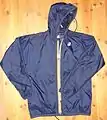Cagoule
A cagoule (French: [kaɡul]), also spelled cagoul, kagoule or kagool, is the British English term for a lightweight (usually without lining), weatherproof raincoat or anorak with a hood, which often comes in knee-length form.[1] The Canadian English equivalent is windbreaker or the French brand K-Way.

In some versions, when rolled up, the hood or cross-chest front pocket doubles as a bag into which the shell can be packed.
History and styles
A cagoule which could be rolled up into a very compact package and carried in a bag or pocket was patented[2] by former Royal Marine Noel Bibby and launched in the UK under the brand name Peter Storm in the early 1960s.[3]
In 1965, the French cagoule brand K-Way was introduced.[2]
Original versions were lightweight and packable with generally an integral hood, elastic or drawstring cuffs, and a fastening at the neck. Usually, the cagoule could not open fully at the front and was pulled on over the head.
As a functional outdoor rain-garment, the original styling and proportions allowed the wearer's small items of personal luggage to be protected – rucksack, waist bag and/or camera bag.
Later copied and marketed as a close-fitting cheap fashion accessory, the style became very popular in the United Kingdom during the 1970s.
Gallery
 Peter Storm vintage cagoule
Peter Storm vintage cagoule Styling made weather protection to typical lightweight items of personal luggage possible
Styling made weather protection to typical lightweight items of personal luggage possible K-Way cagoule
K-Way cagoule
See also
References
- The Chambers Dictionary, 1994, ISBN 0-550-10255-8
- Leitch, Luke (25 April 2014). "How the cagoule became too cool for school". Daily Telegraph. Retrieved 26 June 2015.
- Invisible on Everest—innovation and the gear makers, Cassie Crute and Mary Rose, ISBN 0-9704143-5-8